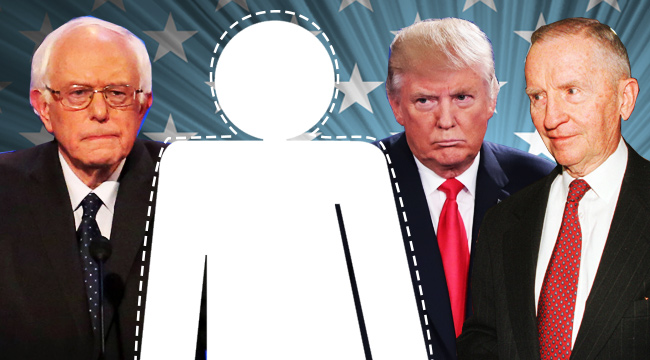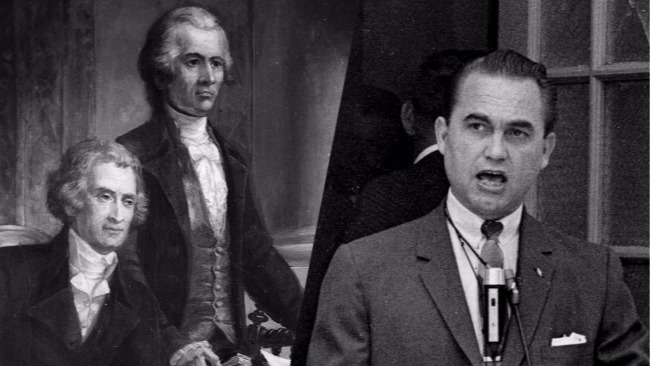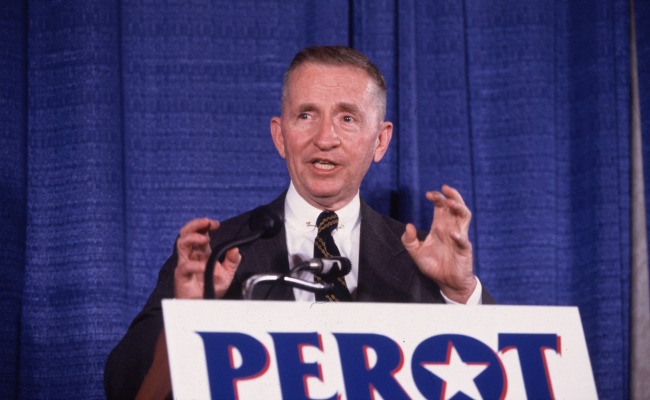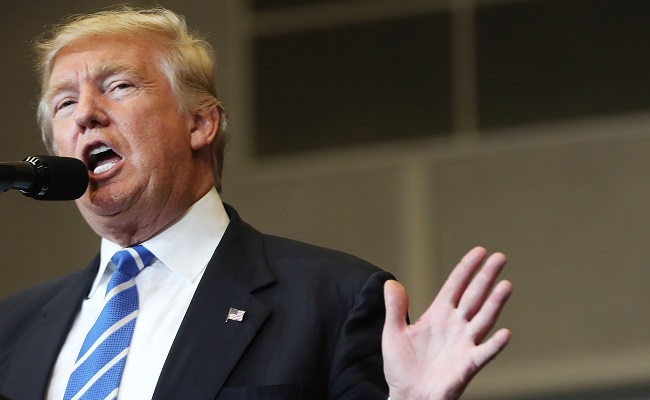
American voters really don’t like Hillary Clinton and Donald Trump. An NBC/Wall Street Journal poll suggests that 51% and 63% of registered voters have an unfavorable view of Clinton and Trump, respectively, making it difficult to imagine any one positive thing that would significantly improve either’s standing before election day. And following the release of Trump’s lewd and concerning remarks against women from 2005 and the constant spread of Wikileaks emails nipping at Clinton’s trustworthiness, it’s easy to envision those numbers getting even worse. But of course, these are our primary options. To the lesser of two evils win the spoils… and, assuming people’s dissatisfaction remains, a one-term presidency with little positive impact.
According to a new Gallup poll, 57 percent of Americans think a theoretical third option is necessary as Democrats and Republicans alone can’t seem to put aside their squabbles to move the country forward, but it’s been hard for voters to codify behind an “Independent” candidate. Sure, the desire is there and an intense curiosity in those candidates and the movements that they have inspired exists, but recent history is littered with the bones of quixotic campaigns that have failed to convert that interest into an actual impact at the polls.
This time around, it’s Green Party candidate Jill Stein (who is polling below the margin of error) and Libertarian Gary Johnson (who has 8% support in the NBC/WSJ poll), who are both no stranger to the seemingly fruitless nature of David vs. Goliath and Other Goliath battling having both run for the Presidency in 2012 as well. Prior to them, Ralph Nader was the nation’s third-party poster-child, but after he was (rightly or wrongly) tagged as a “spoiler” following the 2000 election with many Democrats arguing that he ruined then-candidate Al Gore’s chances in Florida (and thus, the electoral college), Nader’s supporters failed to show up in full force during his subsequent runs for the White House in 2004 and 2008.
Understanding the impact of the 2000 election helps to partially explain the view of third party candidates as lost causes who must be considered and discussed only for their impact on other campaigns, but third-party politics has a much longer, far more successful track record. And when you add that to the growing discontentment regarding the two-party system, you start to wonder if it’s a question of when and not if America will find a third-party candidate with a real shot at winning a Presidential election. And then you start to wonder how we’ll get to that point.
The Birth And Impact Of Third-Party Politics

“To the efficacy and permanency of your Union, a Government for the whole is indispensable,” outgoing President George Washington wrote in his 1796 farewell address. “No alliances, however strict, between the parts can be an adequate substitute.” Despite these qualms, “the danger of parties in the state” Washington feared came to fruition during his tenure from an unlikely source: The Federalist Papers. Specifically co-author Alexander Hamilton, whose Federalist No. 9 concerned itself with “The Union as a Safeguard Against Domestic Faction and Insurrection”:
For all the ire Hamilton and Federalist No. 10 author James Madison had for political factions in 1787 and 1788, Hamilton’s Federalist Party came into being soon after in 1789. Three years later, Madison and fellow founding father Thomas Jefferson’s Democratic-Republican Party, otherwise known as the Anti-Federalists, arose to challenge it.
As David A. Epstein writes in Left, Right, Out: The History of Third Parties in America, these two disparate “ideologies… came to dominate the political discourse in the young republic.” So much so they “would [come to] define — and limit — the nation’s politics to the present day.” After all, modern Democrats trace their party lineage back to Jefferson and Madison. And while the Federalists no longer exist today, their competitive relationship with the Democratic-Republicans ultimately founded the two-party system which persists today.
Epstein goes on to say “third parties have emerged again and again” as “a response to unique historical conditions in the United States.” As a result, some of the larger, more popular third parties — especially those coalescing around presidential candidates — “have all left some legacy in the American political system, the American economy, or American society as a whole.” Like the Republican Party and its first nominee and successfully elected president, Abraham Lincoln.
A lawyer and former Whig Party leader, Lincoln and his supporters rallied around the new partisan group following the split of the Democrats over slavery. He quickly gained followers in the North due to his stance against slavery, but instead of making campaign appearances and giving speeches, Lincoln stayed on the sidelines. Besides, the new party and the voters it attracted were so excited about having a third option — especially one as reportedly grande as Republican speakers and pamphlets claimed — that Lincoln’s success was all but guaranteed.
Over 50 years later, outgoing President Theodore Roosevelt rebelled against the Republican Party when his successor, William Howard Taft, took it in a different direction in the 1908 election. He returned with a vengeance during the 1912 Republican primaries, but thanks to African-American voters in the south, President Taft beat President Roosevelt’s challenge easily. Undeterred, Roosevelt attempted a third-party run for the White House, creating The Progressive Party, which was also known as the “Bull Moose Party.” While Roosevelt was ultimately able to get some form of revenge against Taft by topping him in the popular vote during the general election, then New Jersey Governor Woodrow Wilson was able to cruise to an easy victory over them both (and Socialist candidate Eugene V. Debs), doubtlessly thanks to the fierce competition for Republican-minded voters between the two presidents.
It would take 60 years for another notable third-party candidate to break away from his party and find national attention. Alabama Governor Wallace, a southern Democrat, announced his intent to run for president as the American Independent Party’s nominee in 1968. While Democrat Hubert Humphrey and Republican Richard Nixon duked it out, Wallace attempted something very different. So different, in fact, that National Review founder William F. Buckley Jr. dubbed the southern politico a “country and western Marxist.” The boisterous public speaker used his national notoriety — earned after attempting to defy President John F. Kennedy’s National Guardsmen and their enforcement of desegregation legislation — to appeal for votes from those who felt as though they were being ignored by the two main parties. (That, and racists.)
Wallace’s campaign was raw, offensive, and compared to contemporary third-party candidates, quite notable. Though history only remembers the winners and certainly not the third place finishers, Wallace’s third-party success is still startling: 9.9 million votes (13.5%) and 46 electoral votes. A massive loss to be sure, but an impactful campaign in a time of great strife that identified a voting bloc that other politicians still play too — angry white male “traditionalist” voters.
That success is why, when Wallace died in 1998, The Huntsville Times obituary emphasized the “startling appeal to millions of alienated white voters” that he’d embodied thirty years prior while citing his influence on the establishment politicians that followed him: “First Nixon, then Ronald Reagan, and finally George Herbert Walker Bush successfully adopted toned-down versions of Wallace’s anti-busing, anti-federal government platform to pry low- and middle-income whites from the Democratic New Deal coalition.”
Trying To Find Success In The Media Era

As Lincoln, Roosevelt, and Wallace demonstrate, third-party success is attainable when uniquely compelling figures find a way to channel ample amounts of voter angst, energy, and curiosity. But if that’s so, then why haven’t we seen an easing of the lines between establishment candidates and true independents? Why haven’t we seen a third-party candidate claim the ultimate prize? Part of that has something to do with money (more on that later) and part of it has to do with the rising power of the media in the formation of a candidate’s brand.
Texas businessman Ross Perot challenged Republicans and Democrats’ strict hold on presidential elections in 1992 and is the most successful third-party candidate of the last 100 years in terms of popular appeal (Wallace has him beat on electoral voters since Perot captured none), bagging a whopping 19 percent of the popular vote. That Perot didn’t do better and possibly even win the election is the bigger surprise considering his early popularity.
Introduced to the masses through a wave of free television appearances (and later through paid 30-minute infomercials touting his policies) in an effort to grow a grassroots campaign and gain entry onto the ballot (prior to officially declaring), Perot captivated with a big personality and a set of economic policies — like balancing the budget and saying no to shipping jobs overseas — that appealed to moderates.
Dissatisfied with President George H.W. Bush and mystified by then-Arkansas Governor Bill Clinton (and the continuing swirl of whispered-about scandals that plagued him through the primary), Perot’s strategy was working. In June of 1992, Perot was in the lead of the three-person race with 39% of support followed by Bush at 31% and Clinton at 25%, according to Gallup. By mid-July, however, the bloom on Perot was starting to fade after a series of missteps and a clash with top political advisors over his reluctance to run a more mainstream campaign followed a drop in the polls. Soon, Perot pulled the plug only to return in October, just a month prior to the election.
Could Perot have rebounded and won had he listened to his advisors and stayed in the race instead of abandoning the stage for more than two months?
Perot’s downfall isn’t just about lost momentum, it’s about him losing the ability to control his brand in the modern media era (despite so brilliantly building himself up with the help of the media). All of a sudden, he wasn’t defined as the hard-charging independent Texan on a people-powered rocket ship toward success. Perot’s pre-exit foul-ups and his surprising departure and return allowed the press the chance to (justifiably) ask questions about the candidate and his operation that recast him as stubborn and, thanks in part to Dana Carvey’s impression of him on Saturday Night Live, cartoonish.
By the time the debates came around (which, unlike other third-party candidates before and since, Perot was able to participate in), the public already had a good idea of who Ross Perot was and it wasn’t the version that he had initially tried to establish. It also wasn’t that of a candidate who could win, as is evidenced by exit polls that indicate that 35% of respondents would have voted for Perot if they thought he had a chance.
And that’s the biggest hindrance faced by third-party candidates in the modern media era: the perception that these campaigns can’t possibly be a factor or topple major party candidates despite those past successes and the potential that Perot’s movement briefly had.
It’s all a self-fulfilling prophecy that is partially reinforced by the media’s (understandable) desire to streamline their coverage to focus on those candidates with the surest chance of winning. And when that happens, Ryan Neville-Shepard, Assistant Professor of Communications at the University of Arkansas says campaigns often do something drastic to get noticed, like having an “Aleppo moment” or crashing another party’s convention. “Any of these desperate third-party candidates who want to get out their message have to do really extreme acts that eventually disqualify them,” he explains. In other words, this is what a third-party candidate most often looks like when they do find a way to get on television.
Naturally, creeping obscurity and stunts have a way of dampening a campaign’s poll numbers which leads to being shut out of the debates due to a methodology that Neville-Shepard says takes into account polls that are sometimes stacked against those campaigns.
“We have the Commission on Presidential Debates that decides [Gary Johnson] needs 15 percent. The question is, why isn’t 10 percent good enough? Where did you get 15 percent from? Moreover, when he ran in 2012, they argued if he averaged 15 percent in five national polls then he’d qualify. In 2012 he wasn’t even included in many of those national polls, so you couldn’t even gauge whether or not he was even close to 15 percent.”
Unsurprisingly, both Johnson and Jill Stein failed to qualify for inclusion in the 2016 debates due to their low poll numbers — even though a USA Today poll in which 76% of respondents want third-party candidates on the debate stage. But with high disapproval ratings plaguing both Trump and Clinton as a cascade of scandals threaten to reframe the race every day while voters are simultaneously at the high point of their engagement with the race and the issues, isn’t it the perfect time to give them an alternative option even if those options are lacking in widespread support going in?
Trump, Bernie, And The Future

While Perot’s campaign was buoyed and then redefined by old media (cable news, print), the possibility exists for the right candidate to come along and spark a lasting movement fueled by social media and millennial voters — an ever-present content factory and the gateway to the demographic that all forms of media target. The trouble is, independent-minded candidates with mainstream appeal like Bernie Sanders and Donald Trump are, at least in 2016, resisting the uncertain road of independence and trying to reform the two major political parties from within while using the passion and resources of connected voters.
“Trump’s style is very much along the lines of what we’ve seen third party candidates do,” says Neville-Shepard, adding, “He’s polarizing to a degree that we’ve probably never seen. He’s extremely populist in his style… He’s very funny, albeit in offensive ways, but he embraces that… He has this really funky, crazy hair and orange face, and he embraces the image. It’s what makes him look and sound and feel very different from anybody else.”
Though Sanders’ campaign ultimately failed, it’s worth noting that the Independent senator was able to command a great deal of media attention without falling into the typical third-party traps while taking on a heavily favored mainstream candidate (Hillary Clinton) with a more impressive organization (and a few other advantages). And that’s a huge win and an indication that, with the right circumstances, an independent-minded politician can still get the media’s attention if they have a passionate and youthful movement behind them.
So, are Sanders and Trump the death of third-party politics in that they attained their highest levels of support only because of the Democratic and Republican parties? Or are they shining examples of what can be achieved when a candidate recognizes, and uses, the frustration and resolve of an increasingly vocal group of voters who don’t like picking between two choices every four years?
It might be both.
With the way the cards are stacked against candidates like Stein, Johnson, and Nader, it truly feels like fringe candidacies will never gain enough momentum or support. Presidential elections are, at their core, about ideas, and no movement can obscure the policies that underwrite it (even if it feels like there’s a concerted effort to try sometimes). People just aren’t interested in what Jill Stein or Gary Johnson are selling. If it was in a different package, or sold by a more gifted salesperson, those ideas might get a little further. But they are still far away from the mainstream and thus, doomed to win only nominal support and attention. Should Johnson be in the debate despite that? Absolutely, but his is not a campaign whose true destiny is being hampered. We’re talking degrees of successes, not a full victory.
The mistake that most observers make is to assume that Democrats and Republicans speak for the mainstream voter, but in truth, both parties strain to cover a portion of the middle while paying service to their base — a group of passionate voters that they each know will be there with open wallets and a willingness to get loud. Independent moderate voters go along for the ride each election, in part, because independent candidates typically set their sights on those same extremes. There’s no one there for the true middle. Ross Perot got that, but lacked the acumen and polish to affect real change from the center out.
The first ever truly successful third-party candidate will get it too. They’ll also be filthy rich (and willing to fund their own campaign for reasons practical and superficial), incredibly entertaining (so as to hold the media’s attention), and lucky. In short, the perfect candidate. But with the scorched earth profile of this election and the level of dissatisfaction at an all time high, the environment in which to launch of a smart, nimble, and centrist independent campaign is now. Because despite the left and right swings that this country goes through, it’s practical moderates that have the real numbers in this country, not partisan moderates.

